What kind of leaves do shrimp eat? In the wild, a lot of leaves will fall in the streams and waterbodies shrimp live in. Leave litter gives off beneficial properties to the water and the shrimp and other wildlife benefits from them, and can feed off them. There are a lot of options you can use to get this in your tank. You might be wondering: what can I feed my shrimp? We will take a look at the 13 most used leaves to feed your shrimp.
What leaves do shrimp eat? Shrimp eat Indian almond leaves, Nettle leaves, Guava leaves, mulberry leaves, Walnut leaves, Peppermint leaves, Banana leaves, Spinach, Oak leaves, Birch leaves and Beech leaves.
As you can see, there are a lot of different leaves you can feed your shrimp. We will take a closer look at them and some tips on using them.
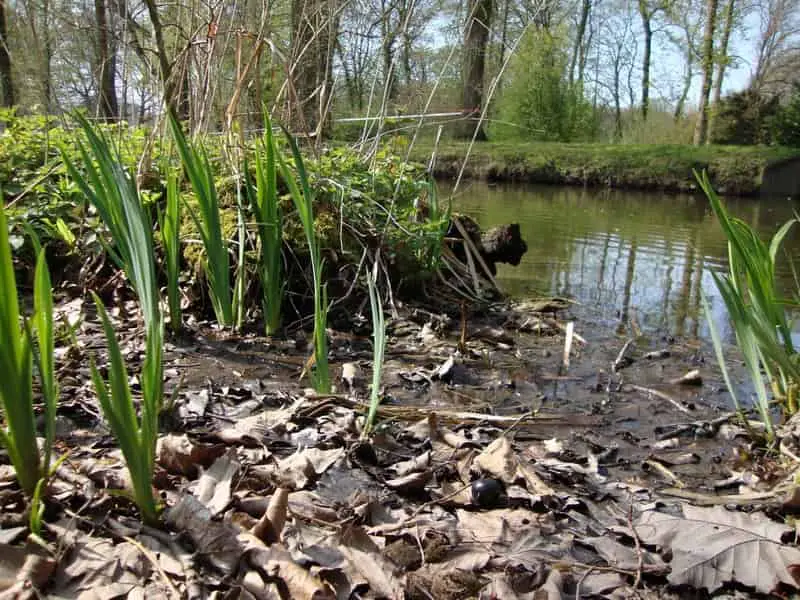
Indian almond leaves
Indian almond leaves or Catappa leaves reduce the pH. They have an antibacterial effect. They give the aquarium a natural look, strengthen the colors of fish and shrimp, reduce stress, and work preventively against diseases in the aquarium.
Shrimp find the leaves and the biofilm that will form on it very tasty. The leaves are, therefore, an excellent supplement.
We have another article that takes a more in-depth look at Indian Almond Leaves for your shrimp.
Nettle leaves
After Catappa leaves, maybe the most commonly used leaves are Nettle leaves for shrimp. Nettle leaves are very rich in various nutrients, silicates, and fibers. The high content of silicates is especially essential for shrimp. Silicates support the shedding and strengthening of the shrimp’s outer shell. The nutrients and fibers are also very beneficial to the growth and development of shrimp. The fibers stimulate the intestinal tract; that way, nutrients can be absorbed better.
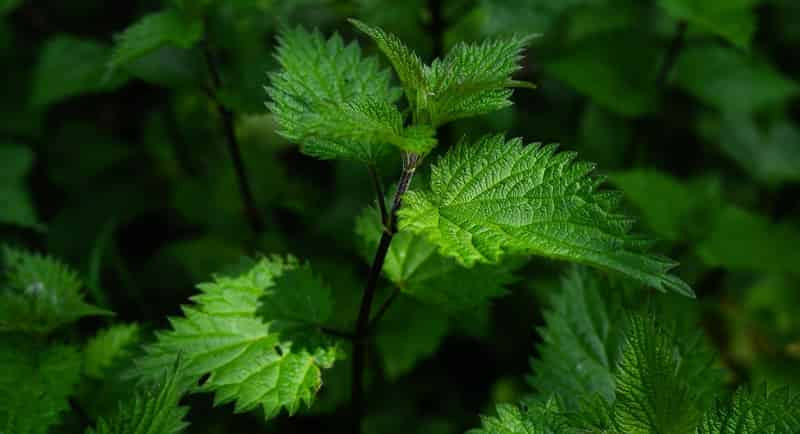
Guava leaves
Guava leaves are the ideal supplement for freshwater shrimp and other invertebrates. Guava leaves have an antibacterial effect against worms, infections, and bacteria that cause diseases. It works in preventing the Vibrio bacterium that is the cause of many shrimp diseases. In many ways, they are similar to Catappa leaves only tougher and will take longer to decay. They are a good source of natural food for shrimp, dwarf lobsters, snails, and small catfish (pleco’s).
Tip: pouring over with boiling water ensures that the leaves will sink faster.
Guava leaves dosage
Use about one leave per 10 gallons or 40 liters.
Mulberry leaves
Mulberry leaves full of nutritious vitamins, including vitamin A (beta-carotene), B1 and B2. They are also a great source of minerals such as magnesium, iron, and zinc, along with essential electrolytes such as sodium and potassium. The many carbohydrates and fibers make the mulberry leaves part of a varied diet.
Use the dried mulberry leaves as an organic, vitamin-rich treat to promote successful scaling (shedding) and scale growth for all types of shrimp.
Mulberry leaves generally have about 43% of Carbohydrates, 25% Fat, 24% of Protein, and 6% Fiber.
Mulberry leaves dosage
Use about one to two leaves per 10 gallons or 40 liters.
Walnut leaves
Walnut leaves are a real delicacy for shrimp. I still need to try these out for myself, but I heard from a lot of shrimp keepers how much their shrimp love these. Walnut leaves also contain a lot of fibers and nutrients, which makes the leaves an excellent supplementary food.
The walnut leaves have an antibacterial effect thanks to tannins, enzymes, humic acids, and chlorophyll. The leaves also promote the immune system of shrimp.
Teak leaves
Teak leaves have a similar effect as Catappa leaves but without the brown discoloration of the water. Teak leaves contain tannins that get released into the water after adding the leaf. These substances are disease-resistant and slightly lower the pH.
It takes a long time for teak leaves to decay in the water. Where a Catappa leaf decays after about a month, a teak leaf takes about two months. In this way, you can benefit from leaves in various stages of decomposition in the water.
Shrimps eat the soft leaves and can this way have food for a long time.
Teak leaves dosage
Give approximately 1/4th leaf per 10 gallons or 40 liters of water. You can easily cut the leaves to size with scissors.
Amaranth leaves
Amaranth leaves are not yet widely known, but offer specific benefits for the shrimp. You can use these leaves as supplementary food for shrimp.
The benefits of Amaranth leaves for your shrimp are they keep their shells healthy and helps the shrimp when shedding. The leaves are also high in fiber, vitamins, minerals, and carbohydrates.
Amaranth leaves are usually cooked and air-dried when you buy them. In this way, they preserve the nutritional value in the amaranth leaves.
Amaranth leaves dosage
Feed the Amaranth leaves about once or twice a week. One leaf is usually sufficient.
Banana leaves

Banana leaves have been used for shrimp for a long time. Like the Catappa leaves, to help in the treatment and prevention of diseases. The banana leaves, in contrast to the Catappa leaves, also help provide more intense colors to your shrimp and fish. They are not yet available in many places. As a result, banana leaves for the aquarium are not however very well known.
Spinach
Whereas most leaves in this article have a positive effect on water conditions, and a food source, spinach is only an excellent food for your shrimp. It is full of vitamins, minerals, and calcium, which they need for their shells.
If you give Spinach leaves for your shrimp, make sure that it is insecticide and pesticide-free. One easy way to guarantee this is to grow it yourself.
Your shrimp will not only like the fresh spinach leaves but also frozen spinach can be given to your shrimp.
You can Blanche fresh spinach before adding it to your shrimp tank. Frozen spinach you have to thaw first. Just put it in a bit of water till defrosted and strain the leaves before you add it to your aquarium.
Oak leaves
You can use oak leaves for your shrimp tank. They have similar properties to Indian Almond leaves. They will release beneficial tannins in the water. Oak leaves are widespread in most of North America and Europe.
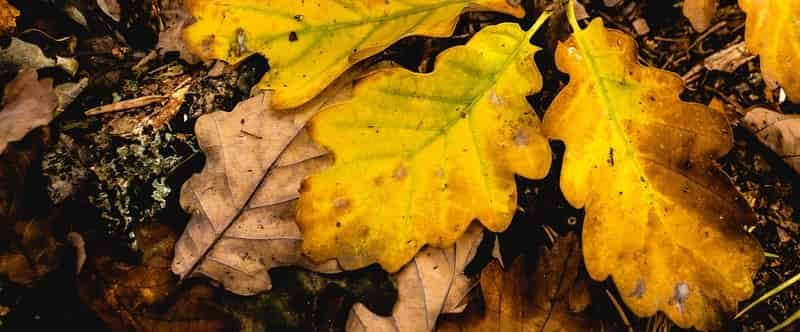
here is an article on all you could ever want to know about Oak leaves
Birch leaves
Birch leaves have similar effects on the water as most leave litter. The advantage of using Birch leaves in your shrimp tank is their size. You don’t have to cut them up when you dose a small aquarium.
Beech leaves
Beech leaves have similar effects on the water as most leave litter. The advantage of using Beech leaves in your shrimp aquarium is the same as with birch leaves. They are small, so ideal for nano tanks and they don’t color the water as much as Catappa leaves.
Hornbeam leaves
Be careful using hornbeam leaves for your shrimp. I have heard mixed reports about them. Some people claim they are toxic to your shrimp while others claim you can use them safely in your shrimp tank. They can lover the PH of your water very fast compared to other leaves. I have no experience with them, so I don’t know if they are safe to use. I am a bit reluctant to try them. If you have, let me know your experience with them.
Alder Cones
Alder cones for your shrimp. Technically we can’t consider them leaves, I know, but they have some similar properties as some of the leaves described here. That’s why I wanted to include them in this article.
Alder cones have long been used in aquariums due to the positive effects of the plugs. Alder cones release tannins that lower KH in a natural way. By lowering the KH, the water becomes softer and more acidic. However, the pH reduction remains low, and you can take into account a pH decrease of a few tenths. How far the pH lowers, of course, depends on the size and decoration of the aquarium. For example, Calcium-containing stones and nutrient media in the aquarium can prevent this effect from taking place.
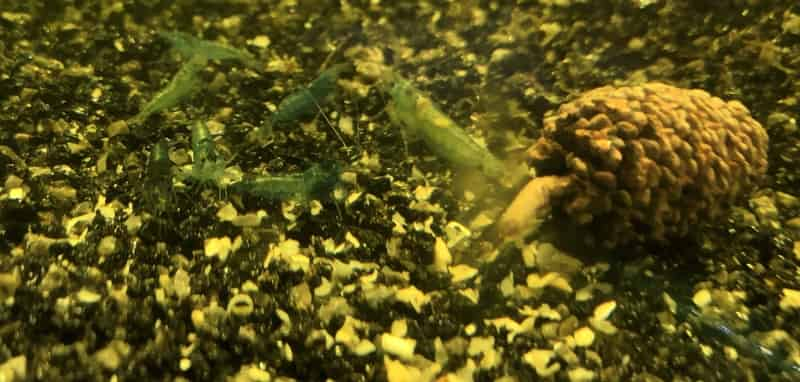
The tannins released by the alder plugs are bacteria and fungus resistant and ensure and reduce stress. In this way, they are similar to the Catappa leaves. These tannins give the water a light red/brown color. This coloring is only temporary. These tannic acids also prevent the formation of beard algae. Alder cones are also very suitable for creating a blackwater biotope not only shrimp will love.
How many Alder cones in your shrimp tank?
Dosage: One cone per 10 liters or about two and a half gallons of water.
The alder plugs release the active substances for about a month to six weeks. After this time they can be replaced, but it is better to leave them in your aquarium. The alder cones become soft and can be eaten by shrimp together with the biofilm that will have formed on them.
Conclusion
You can find leave litter for you shrimp aquarium all around you in garden, parks, and nature. There are many leaves with beneficial properties and a lot of places where you can find then. When collecting leaves, try to stay away from busy roads, industrial arias, and areas where there is a chance they have used pesticides or fertilizers. If you’re in doubt, you can also consider to buy them. Try to buy them from a store you know or read store reviews to make sure they are from a reliable source.
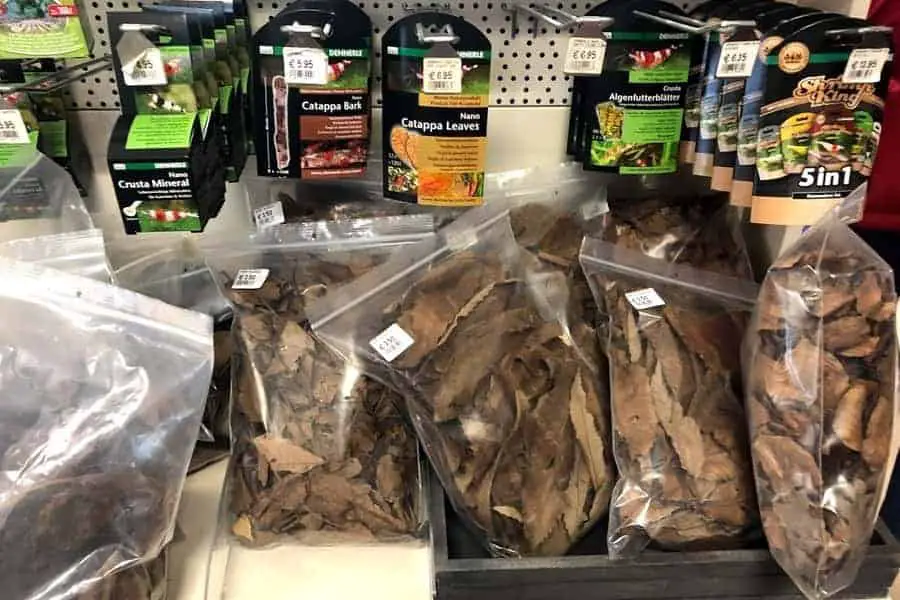
Related Questions
Do I need carbon in my aquarium filter? The use of activated carbon in your filter for your shrimp aquarium will reduce or eliminate the beneficial effect of the leave litter. We, therefore, advise you not to use activated carbon in your shrimp tank.
Can I use fruit tree leaves for my shrimp? You can use most leaves of fruits for your shrimp. You can use, for example, Cherry, Apple, Pear, and Plum leaves. When you use fruit tree leaves, you have to be extra careful. Fruit trees have a high risk of being treated with pesticides. Even traces of pesticides or fertilizers can be deadly to your shrimp and fish.
